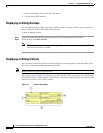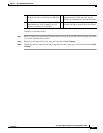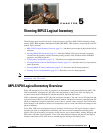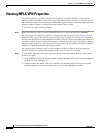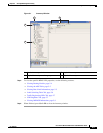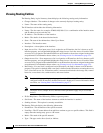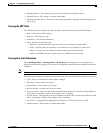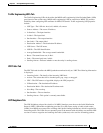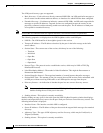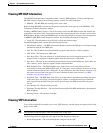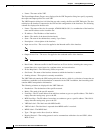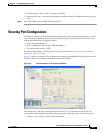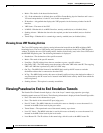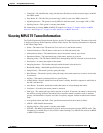
5-6
Cisco Active Network Abstraction 3.6.6 MPLS User Guide
OL-19192-01
Chapter 5 Viewing MPLS Logical Inventory
Viewing MPLS VPN Properties
Viewing a Label Switched Entity
The LSEs logical inventory branch displays incoming and outgoing label information. The Label
Switching Properties window might contain the following tabs, which are described in the following
sections:
• MPLS Interfaces Tab, page 5-6
• Label Switching Table Tab, page 5-6
• Traffic Engineering LSPs Tab, page 5-7
• Traffic Engineering LSPs Tab, page 5-7
• LDP Neighbors Tab, page 5-7
MPLS Interfaces Tab
The MPLS Interfaces tab provides information about the MPLS interfaces. The following information
is displayed:
• ID—The interface identification.
• Distribution Protocol Type—The protocol used to establish the session, which may be LDP (Label
Distribution Protocol) or TDP (Tag Distribution Protocol).
• MPLS TE Properties—Indicates whether or not MPLS traffic engineering (TE) properties are
included, either checked or unchecked.
• Sending Alarms—Indicates whether or not the interface is sending alarms.
Label Switching Table Tab
The Label Switching Table tab describes the MPLS label switching entries used for traversing the MPLS
core networks. The following information is displayed:
• Incoming Label—The details of the incoming MPLS label.
• Action—The type of action, namely, POP, swap, aggregate, or untagged. If an action is defined as
POP, an outgoing label is not required. If an action is defined as untagged, an outgoing label is not
present.
• Outgoing Label—The details of the outgoing MPLS label.
• Out Interface—The name of the outgoing interface, displayed as a hyperlink to the device physical
inventory port subinterface.
• IP Destination—The IP address of the destination network.
• Destination Mask—The subnet mask of the destination network.
• Next Hop—The IP address of the next MPLS interface in the path. The IP address is used for
resolving the MAC address of the next MPLS interface that you want to reach.
• Sending Alarms—This option is currently unavailable.
When a TE tunnel starts, you can view the initial TE tunnel information by selecting the LSEs/Label
Switching sub-branch and viewing the information displayed in the Traffic Engineering LSPs tab. For
more information, see Viewing MPLS TE Tunnel Information, page 5-13.



